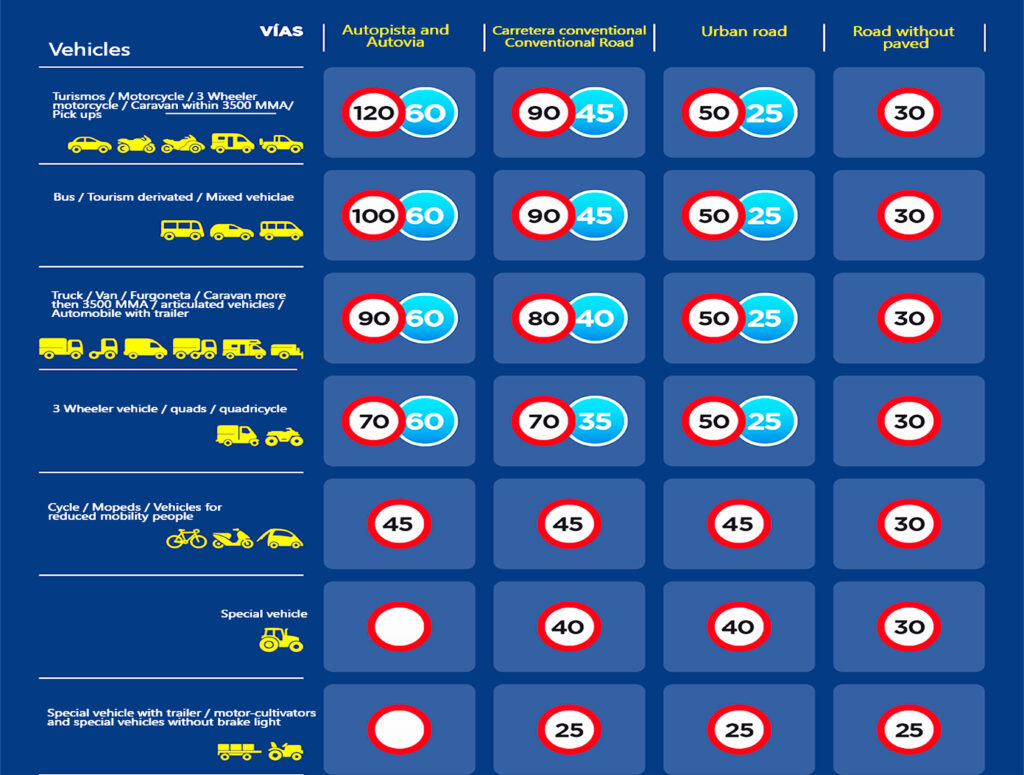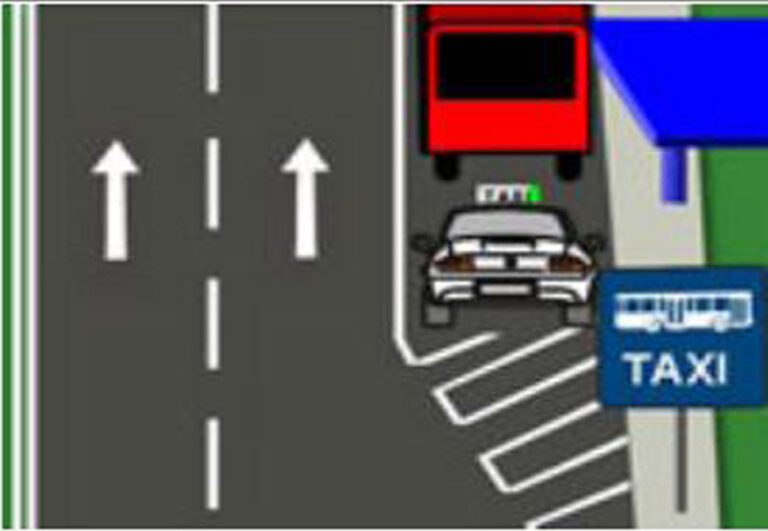
The different types of speed are:
Maximum speed / সর্বোচ্চ গতি
Minimum speed / সর্বনিম্ন গতি
Excessive speed / অতিরিক্ত গতি
When driving at a speed higher than the maximum speed allowed, you are driving at excessive speed.
যখন আপনি অনুমোদিত গতির চেয়ে অতিরিক্ত বেশি গতিতে গাড়ি চালান।
Abnormally reduced speed
অস্বাভাবিক কম গতি
When driving at a speed lower than the minimum speed allowed, you are driving at an abnormally slow speed.
যখন আপনি অনুমোদিত ন্যূনতম গতির চেয়ে কম গতিতে গাড়ি চালান সেটা অহাভাবিক ধীর গতি।
Inadequate speed
/অনুপযুক্ত গতি
When driving at a speed that is not adapted to the weather conditions or the circumstances of the road, traffic, the vehicle or the conditions of the driver.
আবহাওয়ার পরিস্থিতি বা রাস্তা, ট্র্যাফিক, যানবাহন বা ড্রাইভারের শর্তের সাথে খাপ না খাইয়ে এমন গতিতে গাড়ি চালানো।
এটি হতে পারে যে গাড়িটি যে গতিতে চলাচল করছে তা রাস্তার জন্য অনুমোদিত সীমার মধ্যেই রয়েছে তবে সমস্যাযুক্ত পরিস্থিতিতে গাড়িটি নিয়ন্ত্রণে চালকের প্রচুর অসুবিধা রয়েছে। উদাহরণস্বরূপ, বর্ষার দিনে সাধারণত অনেক বেশি দুর্ঘটনা ঘটে কারণ প্রচুর চালক রোদ। এর দিনের মতো একই সতিতে গাড়ি চালায়, অর্থাত্ তারা বৃষ্টির দিনে অনুমতিপ্রাপ্ত তবে অনুপযুক্ত গতিতে গাড়ি চালায়।
Adequate speed
/ উপযুক্ত গতি
When driving, adapting speed to changing traffic, road, vehicle or driver conditions.
যখন আপনি আপনার গতিটি ট্র্যাফিক, রাস্তা, যানবাহনের পরিস্থিতি বা ড্রাইভারের অবস্থার সাথে মানিয়ে নিয়ে ভ্রমণ করেন।
The proper speed is always below the maximum speed and above the minimum speed. but it is not equal to either of the lwo.
যথাযথ গতি সর্বদা সর্বোচ্চ গতির নীচে এবং সর্বনিম্ন গতির উপরে থাকে তবে এটি উভয়ের কোনওটির সমান নয়।
Circulating with an adequate speed we will be able to control our vehicle in the face of any obstacle or unforeseen event that may arise.
পর্যাপ্ত গতিতে চলাচল করলে আমরা যে কোনও প্রতিবন্ধকতা বা অপ্রত্যাশিত ইভেন্টের সম্মুখীন হলে আমরা আমাদের গাড়িটিকে নিয়ন্ত্রণ করতে সক্ষম হব।

Effects of high speed
উচ্চ গতির প্রভাব
Reduces the visual field (tunnel effect)
দেখার ক্ষেত্র হ্রাস করে
Increases aggressiveness and fatigue
আক্রমণাত্মকতা এবং ক্লান্তি বৃদ্ধি করে
Difficult to control the vehicle
যানবাহন নিয়ন্ত্রণে অসুবিধা হয়
Decreases the ability to anticipate and react
অনুমান এবং প্রতিক্রিয়া করার ক্ষমতা হ্রাস করে
Speed should be reduced in:
Places where there are children, the elderly, the blind or animals nearby.
আশেপাশে শিশু, বৃদ্ধ অন্ধ বা প্রাণী রয়েছে এমন জায়গাগুনি
Unrequlated crosswalks.
অনিয়ন্ত্রিত ক্রসওয়াকগুলি
Areas where you do not have a right-of-way, such as intersections, level crossings, and roundabouts.
যে জায়গাগুলিতে আপনার যাওয়ার অধিকার নেই, যেমন চৌরাস্তা, স্তর ক্রসিং এবং রাউন্ড আউটগুলি।
Bad weather conditions, slippery pavement or when there is the possibility of glare.
খারাপ আবহাওয়া, পিচিছল ফুটপাথ বা যখন ঝলকানি হওয়ার সম্ভাবনা থাকে
In areas of reduced visibility or narrow streets. দৃশ্যমানতা বা সংকীর্ণ রাস্তাগুলির ক্ষেত্রে
When approaching a bus at a stop. একটি বাসের স্টপের কাছে যাওয়ার সময়

The generic speed limits on urban roads, depending on the characteristics of the road, are as follows:

a) 20 km / h on roads that have a single road and sidewalk platform.

b) 30 km / h on single lane roads in each direction of travel.
c) 50 km / h on roads with two or more lanes in each direction of traffic. (40 km / h vehicles transporting dangerous goods)

For these purposes, the lanes reserved for the circulation of certain users or exclusive use of public transport will not be counted.

For these purposes, the lanes reserved for the circulation of certain users or exclusive use of public transport will not be counted.
These limits can be reduced or increased by the Municipal Authority after specific signage.
In the crossings, a limit of 50 km / h is set for all types of vehicles, except for vehicles that
transport dangerous goods, which will be 40 km / h. This limit may be lowered by agreement
of the Municipal Authority with the owner of the road, after specific signaling.
To calculate it in a simpler way, we can say that it is advisable to leave 3 seconds away with the vehicle in front
Important concepts: reaction time, reaction distance and stopping distance
Reaction time: it is the time that passes between when the driver perceives a stimulus until he reacts. The average reaction time is around 0.75 seconds.
we circulate.
Reaction distance: is the distance the vehicle travels during the reaction time. It is directly related to the speed at which
Braking distance: is the distance traveled from when the driver applies the brake until the vehicle stops.

